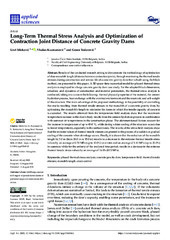Приказ основних података о документу
Long-Term Thermal Stress Analysis and Optimization of Contraction Joint Distance of Concrete Gravity Dams
| dc.creator | Mirković, Uroš B. | |
| dc.creator | Kuzmanović, Vladan | |
| dc.creator | Todorović, Goran | |
| dc.date.accessioned | 2023-01-31T11:58:47Z | |
| dc.date.available | 2023-01-31T11:58:47Z | |
| dc.date.issued | 2022 | |
| dc.identifier.issn | 2076-3417 | |
| dc.identifier.uri | https://grafar.grf.bg.ac.rs/handle/123456789/3011 | |
| dc.description.abstract | Results of the conducted research aiming to demonstrate the methodology of optimization of dam monolith length (distance between contraction joints), through monitoring the thermal tensile stresses during construction and service life of a concrete gravity dam that is built using the block method, are presented in this paper. A 3D space–time numerical model for phased thermal stress analysis is employed in a large concrete gravity dam case study. For the adopted block dimensions, schedule, and dynamics of construction and material parameters, the thermal stress analysis is conducted, taking into account the following: thermal physical properties of the material, the cement hydration process, heat exchange with the external environment and the reservoir, and self-weight of the structure. The main advantage of the proposed methodology is the possibility of controlling the cracks resulting from thermal tensile stresses in the monolith of a concrete gravity dam, by optimizing the monolith’s length to minimize the zones in which the tensile capacity of concrete is exceeded. The results obtained from the temperature field analysis show that the maximum temperature increase in the dam’s body results from the cement hydration process in combination with summer air temperatures in the construction phase. The aforementioned factors account for the increase in temperature of up to 45.0 ◦C, while during winter cooling of the structure occurs due to lower temperatures, especially in the surface zones. The results of the stress field analysis show that the extreme values of thermal tensile stresses are present in the process of a sudden or gradual cooling of the concrete when shrinkage occurs. Finally, it is shown that the reduction of the monolith length by 5.0 m (from 20.0 m to 15.0 m) results in a decrease in the extreme thermal tensile stress values by an average of 0.70 MPa (up to 12.0%) in winter and an average of 1.10 MPa (up to 20.0%) in summer; while for the entirety of the analyzed time period, results in a decrease in the extreme thermal tensile stress values by an average of 16.0% (0.93 MPa). | sr |
| dc.language.iso | en | sr |
| dc.publisher | MDPI | sr |
| dc.rights | openAccess | sr |
| dc.rights.uri | https://creativecommons.org/licenses/by-nc-nd/4.0/ | |
| dc.source | Applied Sciences | sr |
| dc.subject | phased thermal stress analysis | sr |
| dc.subject | concrete gravity dam | sr |
| dc.subject | temperature field | sr |
| dc.subject | thermal tensile stresses | sr |
| dc.subject | monolith length | sr |
| dc.subject | crack control | sr |
| dc.title | Long-Term Thermal Stress Analysis and Optimization of Contraction Joint Distance of Concrete Gravity Dams | sr |
| dc.type | article | sr |
| dc.rights.license | BY-NC-ND | sr |
| dc.citation.rank | M22~ | |
| dc.citation.spage | 8163 | |
| dc.citation.volume | 12 | |
| dc.identifier.doi | 10.3390/app12168163 | |
| dc.identifier.fulltext | http://grafar.grf.bg.ac.rs/bitstream/id/11429/bitstream_11429.pdf | |
| dc.type.version | publishedVersion | sr |

